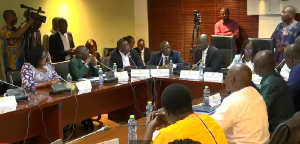Africa News of Thursday, 10 November 2022
Source: face2faceafrica.com
Myrtilla’s tombstone shows African slaves were in Britain in 1700s before Black Roman soldiers pitched tents in UK
The gravestone is the only surviving memorial of the enslaved African girl whose name was given as Myrtilla. It is situated at the St. Lawrence Parish Church, Oxhill, Warwickshire where she had lived during the early 18th century.
On it is an inscription that provides terse details of her identity, her slaveholder, day of baptism and day of burial. It is considered, according to author Remi Kapo, one of the oldest tombs of someone of African origin in Britain. The details of the gravestone suggest she worked for Thomas Beauchamp as a slave.
Prior to the restoration of the grave in 1969 and subsequent relocation to the churchyard in the 1970s, it had the age of Myrtilla. If historical records are anything to go by, Myrtilla should be 112 years old in 2022, suggestive of the fact that she died in 1910. Her tomb has since 1988 been accorded a Grade II status.
Myrtilla is among the few enslaved Africans who were given the honor of having a tombstone in Britain to represent the horrors of slavery and their long journey on the seas to the new world, according to Migration Museum. Their presence and toil predate when the Roman Empire had a stronghold on Britain’s territories.
The Beauchamp family had vested interests in sugar in Nevis and that prompted their migration to England during the early 18th century. There is a high possibility that Myrtilla joined them when they were relocating because of her immense benefit to the family. There are no references to the services she provided under the supervision of the family.
Researcher Barbara Willis-Brown’s attempt to learn more about the black past of the Oxhill community led to the discovery of Myrtilla’s gravestone. One of the historical relics unearthed as part of the search was the Oxhill parish register of 1690 which captured the date another enslaved African girl, Margaret Lucy, was baptized. There was also another adult male enslaved African, Will Archus, who was also baptized in 1700, according to the Guardian.
All three enslaved Africans, according to the Oxhill village website, had an association with Thomas Beauchamp. Thomas Beauchamp is said to have been married to one of the twin daughters of the rector of Oxhill.
Evidence on the website indicates that the slaveholder ensured that all the three slaves were duly baptized and that could have informed why Myrtilla was given a proper burial.There are suggestions that the human nature of Thomas Beauchamp might have been the reason Myrtilla had the opportunity of being honored with a tombstone.
There is however no record of what might have led to the death of Myrtilla. The researcher speculated that she could have possibly died after a short illness or she could not withstand the harsh weather conditions.
Professor of Urban Educational History at Birmingham University Ian Grosvenor said the presence of enslaved Africans may have been a result of the involvement of the English in the transatlantic slave trade. That notwithstanding there was also the presence of Black Roman soldiers who were part of the legion stationed in Britain.
News

Vetting Suspended, Chaos Erupts: What is happening at vetting of Akufo-Addo Supreme Court nominee
Business








